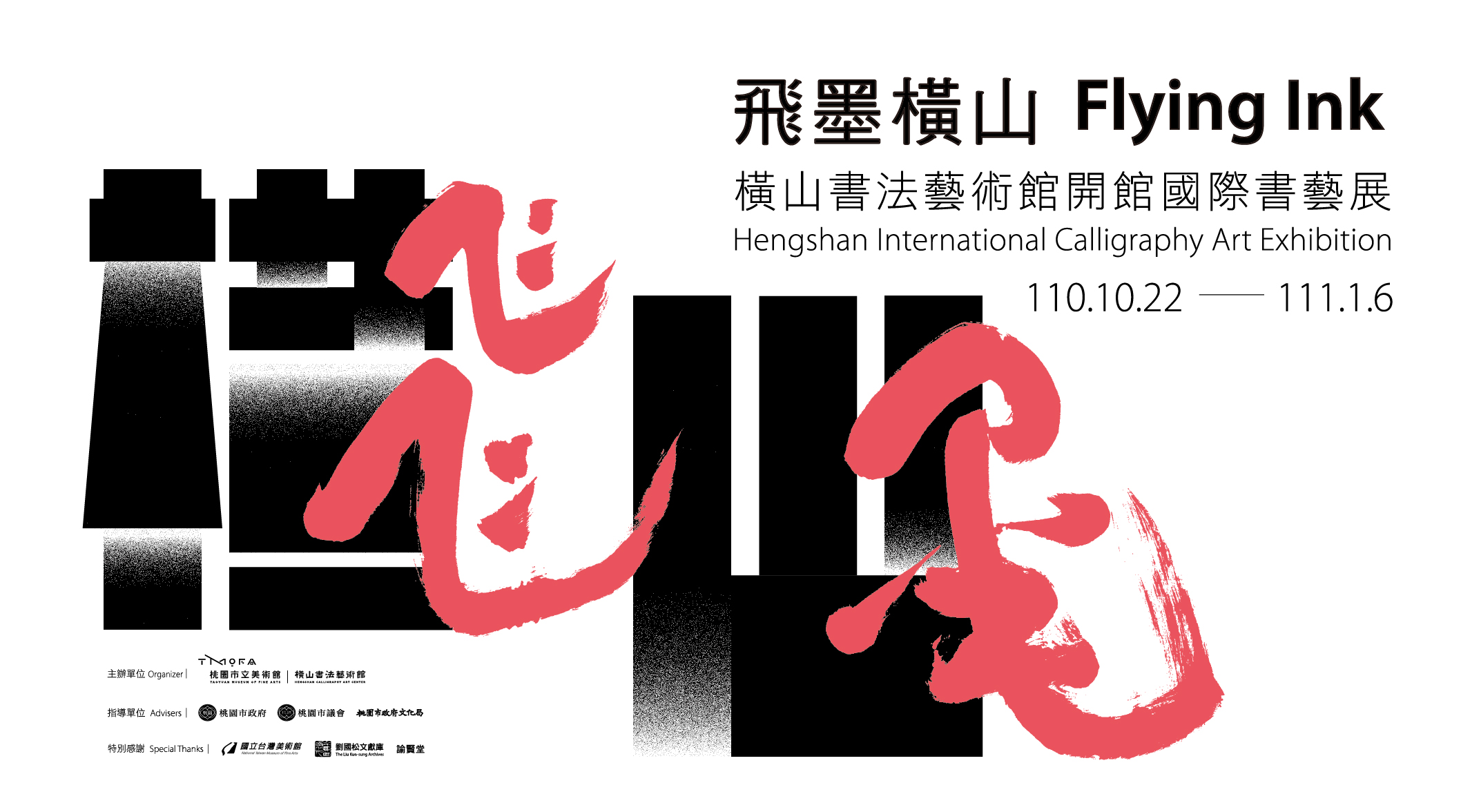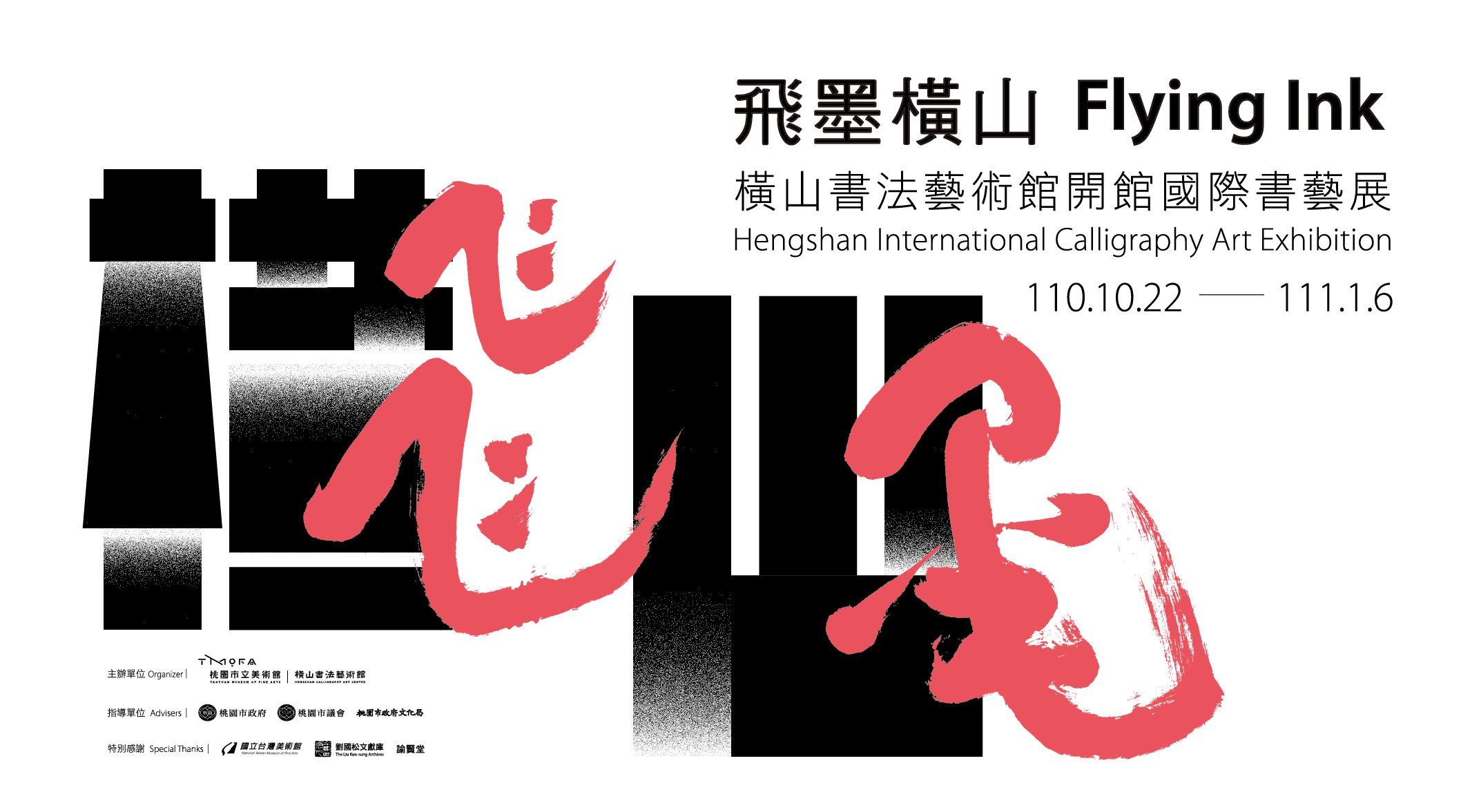Flying Ink: Hengshan International Calligraphy Art Exhibition
- Dates
- 2021/10/22 - 2022/01/06
- Venue
- No. 100, Daren Road, Dayuan District, Taoyuan City, Taiwan
The Hengshan Calligraphy Art Center (HCAC) is the first public calligraphy art center in Taiwan and shoulders the responsibilities of preserving, studying, developing, and promoting Taiwanese calligraphy art, ensuring that regional cultural features take shape through studies and educational endeavors focusing on calligraphy, and facilitating international calligraphy art exchanges.
The Flying Ink: Hengshan International Calligraphy Art Exhibition, the opening exhibition of the HCAC, is curated by Professor Huang Chih-Yang, chair of the College of Art and Design, Huafan University. For the exhibition, the HCAC invits 51 artists from Taiwan, China, Japan, South Korea, Germany, and Finland to exhibit their artworks.
Curatorial Concepts
Contemporary calligraphy is the result of the coopetition between ancient and modern aesthetics and the complex union of art and culture. Calligraphy consists of history, writing, literature, visuals, bodies, concepts, and behavior to be a perfect representative of integrated art. It raises the question of whether to inherit from the past or to create innovations, and challenges contemporary societies to find a balance between visual values and cultural depth. Exhibiting calligraphy displays calligraphy’s roles in globalization and localization and induces the audience to contemplate the ambiguous relationships between time and space, prompting the audience to develop diverse aesthetic values and judgments.
As an art form of Chinese characters with a long history, calligraphy art is traditional, charming, fashionable, retro, persistent, and unique. Thinking about calligraphy art and creating calligraphy art enable people to develop new calligraphy understanding in the 21st century. To reassess calligraphy art possibilities, values, and aesthetics, the optimal methods may be to curate calligraphy art exhibitions, conduct calligraphy art research, and facilitate calligraphy art viewing and dialogues. To realize these methods, this exhibition introduces calligraphy art creation-related tendency and aesthetics as well as the “dialogues” between traditional and contemporary calligraphy art through four subtopics; namely, “traceability,” “novelty,” “interlocutory,” and “interdisciplinary.” The exhibition marks the beginning of Hengshan Calligraphy Art Center’s vista and demonstrates the center’s plan to evolve itself into a key international venue for calligraphy art exchanges.
“Traceability”
The evolution of Chinese characters has given them diversified features, prompting numerous literati and artists to use calligraphy to showcase the unique features of Chinese characters. These efforts subsequently enrich the quantities of visual art produced. At the Flying Ink: Hengshan International Calligraphy Art Exhibition, experienced calligraphy artists utilize their traditional calligraphy knowledge and skills to present Chinese characters perfectly, illustrating their mesmerizing, ingenious thoughts.
“Novelty”
The calligraphy styles present the zeitgeists from different dynasties. For example, Jin, Tang, Song, Yuan–Ming, and Qing dynasty people preached calligraphy styles that focused on grace, system, fun, past-emulation, and high-quality, respectively. In the 20th century, the effects of international art movement, abstract expressionism (which influenced Japan, South Korea, Taiwan, and then China), and Western politics, economics, and cultures revolutionized contemporary calligraphy, shifting it from following traditions and making gradual changes to seeking new, drastic changes. In the early 21st century and contemporary era, calligraphy styles have focused on changes and novelty, respectively, and the objective is to expand from traditions and seek new changes.
“Interlocutory”
Contemporary calligraphy art represents the styles the zeitgeist nowadays and records the unique meanings and values of said era. In the exhibition, calligraphy artists reveal their deep thoughts on their living environments through calligraphy artworks. They escape from traditional patterns and stop imitating traditional styles, resulting in the contemporary calligraphy art deviating from written vernacular Chinese, reaching a state “disrupted communication.” Contemporary calligraphy uses the “languages” of the environments to exemplify the timeliness and vitality of calligraphy art, and highlight how calligraphy art differs from pure visual art in that it embodies a wealth of reading-based characteristics.
“Interdisciplinary”
Through devices, images, and new media, contemporary calligraphy presents the complex relationships between calligraphy, space, time, and the audience. In fact, contemporary calligraphy can be used to show landscape-based living, surviving in environments, and various ideas and philosophies. At the Flying Ink: Hengshan International Calligraphy Art Exhibition, calligraphy art flaunts its charm on walls, boasts its creativity in the exhibition space, and becomes easily accessible to the audience in outdoor environments, sparking their responses. Such a result confirms that calligraphy art from ancient times must be re-examined, reinterpreted, and reused in contemporary environments. By conducting interdisciplinary experiments, we gain insight into the features of calligraphy culture. Subsequently, we link calligraphy and contemporary art concepts together to deepen and broaden calligraphy art presentation, inaugurating new possibilities. Whether such possibilities will become the mainstream possibilities in art venues in the 21st century remain to be seen.
Curator:HUANG Chih-Yang
Artists:Abugy, Along CHEN, BAI Di, CHANG Ben-Huang, CHANG Jih-Kuang, CHANG Mu-Hsi, CHEN Kun-I, CHEN Ming-Te, CHEN Shih-Hsien, CHENG Chin-Fa, CHENG Tai-Le, FUNG Ming-Chip, GU Wenda, HONG Sio-Pang, HSIAO Shih-Chiung, HSU Yung-Chin, HU Kangmei, HUANG I-Ming, HUANG Tsung-I, HWANG Bang-Yeon, JI Zhi-Shan, JUN Jin-Won, KAWACHI Toshiharu, KIM Byeong-Gi, KIM Min-Jung, KO Liang-Chih, KWON Chang-Ryun, LEE Quenten, LI Qing, LIANG Yung-Fei, LIN Chang-Hu, LIN Chin-Chung, LIN Chun-Chen, LIN Jiun-Ting, LIN Long-Dar, LIU Canming, LIU Kuo-Sung, NAKAMURA Nobuo, PARK Won-Gyu, QIU Zhenzhong, SHIH Chun-Mao, TAKAKI Seiu, TANG Kaizhi, TONG Yang-Tze, TSAI Ming-Tzann, TU Chung-Kao, Tuula VELLING, WANG Dongling, WU Ying-Guo, XU Bing, ZHANG Aiguo

